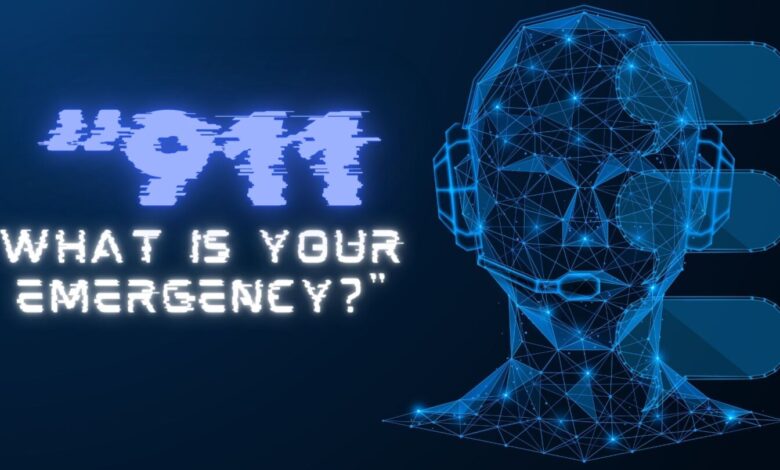How artificial intelligence is reshaping emergency response

This article is based on research conducted as a part of the CA POST Command College. It is a futures study of a particular emerging issue of relevance to law enforcement. Its purpose is not to predict the future; rather, to project a variety of possible scenarios useful for planning and action in anticipation of the emerging landscape facing policing organizations.
The article was created using the futures forecasting process of Command College and its outcomes. Managing the future means influencing it — creating, constraining and adapting to emerging trends and events in a way that optimizes the opportunities and minimizes the threats of relevance to the profession.
By Lieutenant Tyler Jamison
Imagine an emergency response dispatching system smart enough to handle complex incidents with impeccable accuracy and reliability — a system that uses machine learning to analyze calls at lightning-quick speeds and dispatch officers to the scenes of major incidents in seconds. The breakthrough, made possible by using artificial intelligence, would change the landscape for dispatching and policing.
Would dispatchers still be needed? Of course, but primarily for human oversight, decision-making in unique cases and ensuring compliance with enhanced digital regulations. Transitioning away from human dispatchers, in most instances, could quintessentially solve many of the challenges we face today in our emergency call centers.
Are we there yet? Not quite. But it’s only a matter of time.
Maximize resources and focus on the essential
Over the past decade, we have seen a transformative shift in policing as agencies integrate cutting-edge technology such as artificial intelligence and machine-learning algorithms into their daily operations. Although in their infancy, 911 call centers have leveraged AI to automate and streamline repetitive nonemergency tasks, allowing operators to maximize resources and focus more on essential responsibilities.
Cities like San Jose, California; Portland, Oregon; and Austin, Texas have already deployed programs with AI-based virtual agents that answer simple questions and assist with call-taking and information gathering for nonemergency calls. [1] Several technology companies have also partnered with law enforcement agencies to allow users to send pictures and real-time data through app-based platforms. [2] AI has transformed how we collect, process and analyze information.
In fact, in a 2023 Police Chief Magazine article, former chief and current San Mateo County, California Undersheriff Chris Hsiung sat down with subject matter expert Frank Chen, a partner at a Silicon Valley venture capital firm that invests in tech start-ups, to discuss artificial intelligence and how it is impacting law enforcement. During their interview, Chen highlighted chatbots as “already being more useful and empathic than human doctors,” which in law enforcement could mitigate negative interactions and additional citizen complaints while building better relationships with the community. [3] In addition, online financial service companies like Klarna have already shown the success of chatbots: Klarna used them to replace 700 full-time human agents, reducing repeat inquires by 25% and communicating in over 2.3 million conversations in 35 different languages. [4] These capabilities make chatbots well-suited to work in police dispatch centers.
In emergency response dispatching, optimizing our already-scarce resources is critical, as issues with recruitment, retention, higher call volumes and increased job stress negatively impact those who choose careers in this field. Prior to the COVID-19 pandemic, there was already a 15%–20% vacancy rate among dispatchers nationally. Now it is estimated at more than 30%. [5] By integrating system-enhancing tools, though, we can prioritize calls more efficiently, expedite responses, streamline operations and alleviate the workload on existing staff, potentially mitigating the need for additional personnel despite increasing demands. By optimizing resources and operational efficiency, we establish the groundwork for improved accuracy and faster response times, both integral aspects of dispatching emergency calls.
The integration of AI in 911 call centers has been praised for its efficiency, ability to process data at rapid speeds and improved response times for emergency services. For example, Amazon Connect is used in South Carolina call centers for nonemergency calls. The AI system redirects callers to the appropriate resources and has reduced nonemergency call volume by 36%. [6] By leveraging advanced data processing capabilities, AI is designed to make intelligent decisions accurately and can automate call routing to prioritize emergency calls with limited staff availability.
Develop a comprehensive approach to key issues
The outlook of AI in emergency response dispatching offers numerous advantages, but some fear it will replace human dispatchers and the necessity for critical decision-making skills. Fortunately, AI has not yet reached its full potential, leaving room for further development, refinement and crafting hybrid work models that maximize law enforcement services for our communities with both human and synthetic capabilities. Among the capabilities already present are the ways AI performs repetitive tasks without fatigue, freeing its human counterparts for more complex work. That work, though, is only the start.
AI-powered natural language processing technology can capture voice patterns and recognize speech in real-time scenarios. [7] Using AI to rapidly analyze voice patterns could provide insight on one’s emotional state, and officers and dispatchers alike could use this information as an early detection tool to aid with de-escalation – which, according to the National Institute of Justice, is at the core of AI’s goals to enhance public safety. [8] AI language processing, however, specifically emotion recognition, has only shown a 77% accuracy rate, with anger being the most recognizable. [9] While a 23% error rate may be less concerning for nonemergency calls, it becomes significantly more concerning for emergency calls where it could be the difference between life and death, fostering public trust or whether an officer provides timely and efficient response. Certainly, employing chatbots and similar AI systems is the future, but it does not mean concerns do not persist.
Other areas that must also be closely scrutinized to ensure the long-term sustainability of partial or fully autonomous call centers include funding the integration of AI systems, job displacement, cybersecurity threats, community support, environmental impacts and legislative ramifications. To mitigate these challenges, police executives should take decisive action to prepare their departments for this technological pivot, a necessity already recognized by many law enforcement leaders. [10] Department heads must, therefore, adopt a comprehensive and collaborative approach when addressing these concerns. Here are some key aspects of that:
- Police agencies should continuously monitor and capitalize on AI systems as they become available. Use the examples of private call centers like Klarna to guide beta testing to assess accuracy, efficiency and financial sustainability within the boundaries of city or county budgets. [11] In addition, agencies must recognize that improved emotion detection is a unique function that adds a capability to dispatch that does not now exist. As human judgment and discretion would be lost in these situations, police chiefs must assess whether future AI systems possess critical discretionary abilities, an intrinsic value that only occurs in the brain at this time. [12]
- Policing agencies should launch public awareness campaigns through media outlets and public meetings, similar to that done in South Carolina, where the state Department of Public Safety educated community stakeholders about the benefits of AI and challenges the department faces with understaffing and workplace burnout for dispatchers. [13] These campaigns are instrumental in fostering an understanding of AI technology, garnering support, ensuring transparency and maintaining accountability in its adoption.
- Partner with local, county and state legislators to establish guidelines to use AI in 911 call centers, securing legislation that safeguards the integrity of AI systems and regulates their governance in regards to privacy and bias. [14] Legislators, department heads and technology experts must also work together to produce energy-efficient and safe infrastructures supported by equitable laws, as many AI-based language call center models emit large amounts of carbon dioxide. [15]
- Police chiefs should collaborate with their state’s commission on peace officer standards and training (POST) to develop guidelines and training programs for dispatchers to integrate with fully autonomous call centers. This will ensure optimal efficiency, customer satisfaction and workload, as data shows hybrid models currently optimize performance and accuracy. [16]
- Finally, the police should seek technological expertise, not only with vendors and researchers, but with their own city or county IT staff to implement robust cybersecurity measures to shield us against potential threats to AI call centers. Organize town hall/community engagement meetings to inform stakeholders about these security measures, reassuring them of their safety and our commitment to protecting their privacy and security.
Take the first step today
As we look ahead to the next generation of emergency response dispatching, the integration of fully autonomous 911 call centers show significant promise and may be inevitable given the staffing shortages in a tough-to-fill job. Incorporating AI today, even for basic call-taking duties, is a prudent first step in this journey. Thus, when embracing the changes of the digital era, it is essential for police leaders to carefully navigate the complexities and challenges associated with AI integration in 911 call centers without compromising safety, service quality or community support. It is imperative we anticipate pushback and resistance from stakeholders to ensure a successful implementation. Taking a proactive and strategic approach encompassing the recommended practices will allow us to plan for future threats and challenges associated with emergency response dispatching.
NEXT: Dive into a dynamic conversation on the potential and pitfalls of AI in law enforcement, exploring real-world applications, ethical dilemmas and the future of smart policing technologies.
References
1. Edinger J. Can artificial intelligence help with 9-1-1 staff shortages? Government Technology. February 2022.
2. Anderson M. Revolutionizing 9-1-1 with artificial intelligence. The Tech Ranch. 2023.
3. Chen F, Hsiung C. Exploring AI for law enforcement. Police Chief Online. September 2023.
4. Klarna. Klarna AI assistant handles two-thirds of customer service chats in its first month. February 2024.
5. Jenkins A. It’s not just police officers. 911 dispatchers are also in short supply. Northwest News Network. August 2022.
6. Hernández A. AI bots are helping 911 dispatchers with their workload. Stateline. October 2023.
7. Valizada AT. Development of a real-time speech recognition system for the Azerbaijani language. Problems of Information Society. July 2023.
8. Rigano C. Using artificial intelligence to address criminal justice needs. National Institute of Justice. October 2018.
9. Petrushin VA. Emotion recognition in speech signal: experimental study, development, and application. 6th International Conference on Spoken Language Processing (ICSLP 2000). October 2000.
10. Friese G. Advancing policing through AI: Insights from the global law enforcement community. Police1. January 2024.
11. Norris D. Artificial intelligence and community-police relations. Police Chief Online. June 2019.
12. Conti G, Hartzog W, Nelson J, Shay LA. Inefficiently Automated Law Enforcement. Michigan State Law Review. 2016.
13. Colton E. AI is launching 911 call centers into the future with video calls, triaging redundant reports. Fox News. August 2023.
14. Cath C. Governing artificial intelligence: ethical, legal, and technical opportunities and challenges. Philosophical Transactions of the Royal Society A. October 2018.
15. Brevini B. Black boxes, not green: Mythologizing artificial intelligence and omitting the environment. Big Data & Society. July 2020.
16. Kahn LH, Savas O, Morrison A, et al. Modelling hybrid human-artificial intelligence cooperation: A call center customer service case study. 2020 IEEE International Conference on Big Data. December 2020.
About the author
Lieutenant Tyler Jamison is an active California police manager with 18+ years of law enforcement experience. He holds a master’s degree in criminology, law and society from UC Irvine and is scheduled to graduate from California POST Command College in July 2024.



